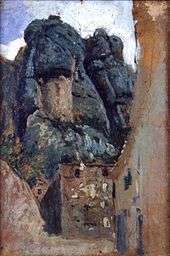Fortuny Museum
| Established | 1956 |
|---|---|
| Location |
San Marco 3958, 30124 Venice, Italy |
| Type | Art museum, Historic site |
| Director | Daniela Ferretti |
| Website | fortuny.visitmuve.it |


The Palazzo Fortuny is an art museum in San Marco, Venice, Italy.
Once owned by the Pesaro family, this Gothic building in Campo San Beneto, near the church of the same name, was transformed by Mariano Fortuny into his own photography, stage-design, textile-design and painting atelier. For a time, the palace was known as the Palazzo Orfei after an 18th-century tenant, a musical society known as the Accademia d'Orfeo.[1] The building maintains the structure created by Fortuny, as well as its collections. The building was donated to the city in 1956 by Henriette Nigrin, Mariano’s widow. The collections within the museum comprise an extensive number of pieces which reflect the various fields investigated by the artist.
The museum is run by the Fondazione Musei Civici Venezia (MUVE).
Collections
- Painting: there are around 150 paintings by Mariano Fortuny, which illustrate the various phases of his career as an artist, where the Wagnerian period (until 1899) holds a central place. A balance of painting and theatre mark an intimate understanding of the dream and myth that thrilled Europe at the end of the 19th century. Also interesting are the portraits, in which the family, and particularly his wife, play a fundamental role.
- Light: the main focus of Fortuny’s work was light design, perfectly identified with the creation of the celebrated theatre dome. This work is found in assiduous chromatic studies, dying of textiles and fabrics and, consequently, in many objects designed for furnishing.
- Photography: photographs exhibited were taken either from the collection left by Mariano Fortuny or from the Musei Civici di Venezia's collection, comprising works from 1850 to the Second World War, in a rich variety of styles, techniques and historic images.
- Fabrics: the collection of clothes, fabrics, prints, materials and ornamental clothes make up a rich sample of Fortuny’s work in the field of fabrics and fashion design, in which the artist took ornamental motifs and reinterpreted them in a modern decorative style. Fortuny drew decorative models and designs from precious Renaissance velvets and from fabrics from exotic cultures.
Temporary exhibitions
The museum is currently open only on the occasion of temporary exhibitions.
- 2013: Paolo Bolpagni (curator), Fortuny e Wagner: Il wagnerismo nelle arti visive in Italia[2]
- 2012: Diana Vreeland. After Diana Vreeland
- 2012: Avere un bella cera
- 2012: Beatrice Helg. "Risonanze".[3]
- 2011: TRA Edge of Becoming
- 2011: Paolo Ventura. L'autonoma
- 2011: Roberta di Camerino. La rivoluzione del colore
- 2011: Michelangelo Penso. Circuito genetico. RSBP
- 2010-11: Nuala Goodman. Gardens
- 2010-11: Luca Campigotto. My Wild Places
- 2010-11: Giorgio Vigna. Altre Nature
- 2010-11: Mariano Fortuny. La seta e il velluto
- 2010-11: Alberto Zorzi. Unicum – Gioielli, Argenti 2000-2010
- 2010-11: Giorgio Morandi. Silenzi
- 2010: Samurai
- 2010: Francesco Candeloro, Città delle Città
- 2009: IN-FINITUM
See also
References
- ↑ The old Venetian palaces and old Venetian folk, By Thomas Okey (1907), page 89.
- ↑ Paolo Bolpagni, Fortuny e Wagner. Il wagnerismo nelle arti visive in Italia, Fondazione Musei Civici di Venezia - Skira, Venezia-Milano, 2012.
- ↑ "Mostra Beatrice Helg Risonanze". Retrieved 15 February 2016.
External links
| Wikimedia Commons has media related to Palazzo Fortuny (Venice). |
Coordinates: 45°26′08″N 12°19′56″E / 45.43556°N 12.33222°E